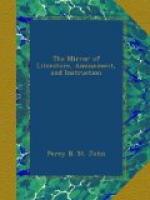5. Pay attention to the character of your subject; mingle not trivial with grand details.
6. One landscape must not be crowded with circumstances sufficient for two or more.
7. It is sufficient to give the principal feature of what you essay to represent; as a castle, abbey, bridge, &c.; but its accompaniments may (and to make a picture, should) be often different. The fore-ground of a drawing must be the artist’s own; and it should be ample, since an extended distance, and a narrow fore-ground is always awkward and bad in a picture—N.B. Taste and observation will direct the student to select for his fore-ground, clusters of trees, pieces of rock, or the fragments of ruined fabrics, &c., according to the nature of his subject.
8. On the accurate observation of distances the beauty of landscape depends; be careful therefore to get them correct at your outset, and to keep them so, by shading lightly with pen or brush your black-lead sketch, (should the parts be complicated,) whilst the view is before you, or fresh in your memory.
9. The hand should be accustomed to the touch of various kinds of trees, though in a mere sketch, little variety is required; the distinction, however, between full foliaged, and straggling, branchy trees must be preserved, for both are necessary even in a sketch, and the artist should therefore be prepared to represent them.
10. The artist must attend to the composition, and the disposition of his subject. By the composition may be understood the objects with which he composes his view; by the disposition, their picturesque and tasteful arrangement.
11. Figures, must be such as are appropriate to the scene; thus, history in miniature is bad, because a landscape is in itself a subject sufficient for the employment both of pencil and eye; therefore historical figures in a view, are lost and out of place.
12. Birds may be introduced with good effect, if thrown into proper distance; to represent them near is absurd: ruins and sea views are the best subjects in which they can appear.
13. Effect is to be produced best, by strong contrasts of light and shade both in earth and sky; but the student’s taste must determine where these shall fall, and though the contrasts should be strong, yet gradation, in both, must be observed.
14. A predominancy of shade has the best effect; and light, though it should not be scattered, must not be drawn, as it were, into one focus.
15. The light, in a picture, is best disposed when the fore-ground is in shadow, and it falls in the middle; but this rule is subject to many variations. Light should rarely be spread on the distance.[5]
[Footnote 5: Extraordinary and beautiful effects, however, are, by superior painters, frequently produced by violating this latter rule. The writer would particularly notice the results of light thrown into the distance, in stormy sea-views.]




